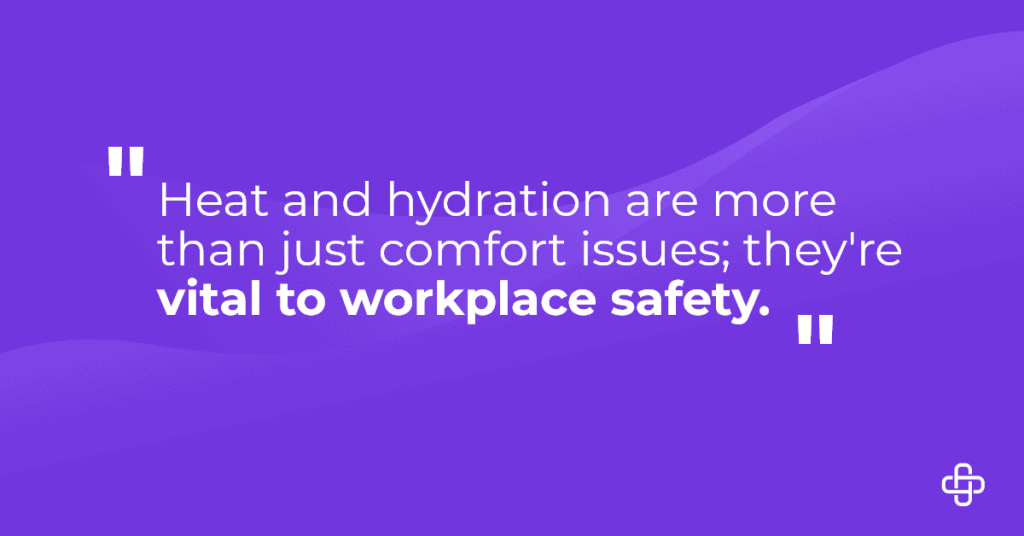When the sun is blazing and temperatures soar, staying cool and hydrated on the job becomes a critical concern.
Whether you’re managing a team of outdoor workers or working in a non-climate-controlled environment, understanding heat safety can be a lifesaver.

This blog will uncover essential insights and practical tips to help you, and your team beat the heat and stay safe.
The Importance of Hydration and Heat Safety in the Workplace
Heat and hydration are more than just comfort issues; they’re vital to workplace safety.
High temperatures can lead to heat stress, which poses significant health risks. Dehydration exacerbates these risks, impairing cognitive and physical functions.
For employers, it’s crucial to ensure that workers are well-hydrated and protected from excessive heat to maintain productivity and, most importantly, safety.
We’ll explore the science behind dehydration and heat stress, identify high-risk environments, and discuss employer and employee responsibilities.
You’ll also find innovative tools and success stories that highlight effective heat safety measures.
The Science of Dehydration and Heat Stress
Dehydration occurs when the body loses more fluids than it takes in. This can lead to heat stress, a condition where the body struggles to cool down.
The physiological effects include headaches, dizziness, muscle cramps, and in severe cases, heat exhaustion or heat stroke. Heat stress impairs judgment and coordination, increasing the likelihood of workplace accidents.
Understanding these risks is key to preventing heat-related illnesses. Staying hydrated helps maintain bodily functions, while proper heat management allows the body to cool down efficiently.
Employers and employees must recognize the signs of dehydration and act promptly to mitigate risks.
Identifying High-Risk Environments
Certain industries and jobs are more susceptible to heat-related illnesses. Examples include:
- Construction
- Agriculture
- Landscaping
- Oil & Gas
Workers in these fields often spend prolonged hours under the sun, exerting themselves physically.
Indoor environments can reach high temperatures, especially without proper ventilation, and also pose risks:
- Warehouses
- Factories
- Kitchens
Recognizing these high-risk environments helps target safety measures effectively, ensuring that workers receive the necessary protections.
Employer Responsibilities for Heat Safety
Employers have a legal and moral obligation to protect their workers from heat-related risks. This includes:
- providing water
- rest breaks
- shaded areas
Safety and risk managers play a crucial role in developing and implementing heat safety protocols.
Best practices include scheduling strenuous tasks during cooler parts of the day, providing training on heat stress symptoms, and encouraging a culture of hydration.
Employers should also monitor weather forecasts and adjust work schedules accordingly. Compliance with OSHA guidelines ensures that safety measures meet industry standards.
Employee Awareness
Workers must be proactive in managing their hydration and heat exposure. Drinking water regularly, even before feeling thirsty, is essential. Electrolyte drinks can also help replace lost minerals.
Recognizing the warning signs of heat stress is vital. Most symptoms require immediate attention, like:
- excessive sweating
- fatigue
- nausea
- confusion
Workers should inform supervisors if they or their colleagues exhibit these signs.
Wearing lightweight, breathable clothing and using sunscreen can further protect against heat. Employees should take regular breaks in shaded or air-conditioned areas to cool down.
Technology and Tools
Innovative solutions can enhance heat safety in the workplace. Wearable devices that monitor body temperature and hydration levels provide real-time data to prevent heat-related illnesses.
Apps and software platforms help track weather conditions and heat indexes, allowing for informed decision-making.
Cooling gear, such as vests and bandanas, offers additional protection. High-visibility clothing with built-in cooling features enhances safety and comfort.
Investing in these technologies demonstrates a commitment to worker well-being.
Axiom Medical’s Solutions for Heat & Hydration Safety
Axiom Medical plays a crucial role in addressing heat-related illnesses in the workplace through our comprehensive injury case management solution.
By integrating physical and mental health assessments, along with fatigue assessments, our approach proactively identifies at-risk employees before issues escalate.
This ensures that workers receive timely interventions tailored to their specific needs, fostering a safer and healthier work environment.
Our dedicated case managers not only guide employees through the recovery process but also provide essential education on heat stress prevention, empowering them to make informed decisions about their well-being in high-temperature conditions.
Conclusion
Staying cool and hydrated on the job is a shared responsibility between employers and employees.
Understanding the science of dehydration and heat stress, recognizing high-risk environments, and implementing best practices are crucial steps.
At Axiom Medical, we’re committed to helping you create a safe and productive work environment. Watch our webinar, “Heat-Related Illness Prevention: Best Practices for Employers,” to learn more about protecting your team from heat-related risks.
Working together, we can ensure that everyone stays cool, hydrated, and healthy on the job.
By following these tips and leveraging innovative solutions, you can safeguard your team against the dangers of heat and dehydration.
Let’s make workplace safety a priority, ensuring that everyone thrives even in the hottest conditions.
Charli Pedersen is a published writer featured on Axiom Medical’s blog. She holds a bachelor’s degree in English, Professional and Technical Writing, and has experience creating content for businesses and non-profit organizations.










